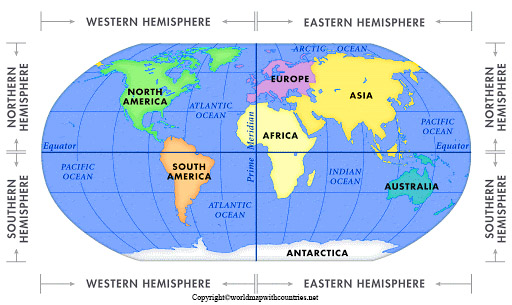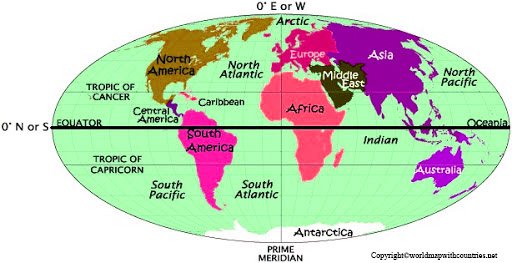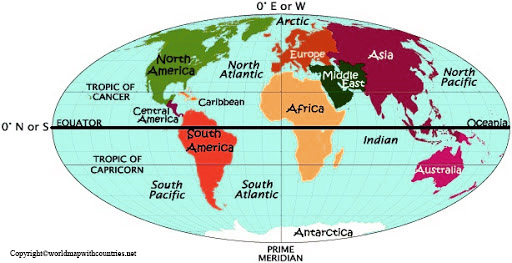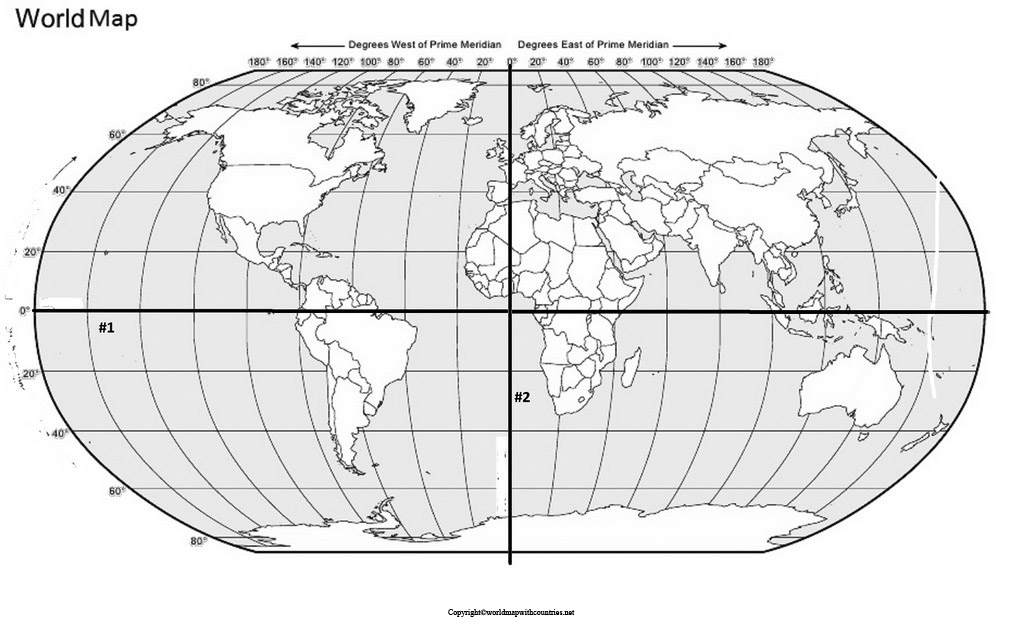
Go through this article for a printable World map with the hemisphere. If you will draw a circle around the Earth, dividing it into two equal parts is a hemisphere. In this way, there are 4 hemispheres: Northern, Southern, Eastern, and Western. Prime Meridian and the Equator are the base of the division of the hemisphere. Longitudes and latitudes maps can also be the base of the division of the hemisphere. Our Printable Hemisphere map is easy to download and use further for locating and analyzing the hemisphere.
A hemisphere is half of a sphere. It can refer to the northern or southern half of the Earth or to half of the celestial sphere. The word hemisphere comes from the Greek word Είδος (eidos), meaning “half”, and σφαίρα (sphaira), meaning “sphere”. A hemisphere can also be used to describe a geometric figure that is half of a sphere, such as a hemispherical cup.
Hemispheres are important in geography and science. They help us to understand the Earth’s climate and seasons. For example, the North Pole is located in the northern hemisphere, while the South Pole is in the southern hemisphere. The Earth’s Equator map divides the planet into two hemispheres, the northern and southern hemispheres. You can download Northern Hemisphere Map from the link.
The term “hemisphere” can also be used to describe other objects in space. For example, the Moon has two hemispheres, the near side and the far side. Mars has three hemispheres, the northern hemisphere, the southern hemisphere, and the eastern hemisphere. It can be divided into two equal parts by any plane that passes through the centre of the sphere. Download Now printable high quality Hemispheres map from the given link.

The Equator, which lies at 0-degree latitude, divides the Earth into the Northern and Southern Hemispheres. These 2 hemispheres vary in the seasons because the Earth is tilted towards the axis and away from the sun. In the Southern hemisphere, June to September months belong to summers; meanwhile, in the Northern hemisphere December to March.
The world map hemispheres can be very helpful in understanding the geographical distribution of the continents and countries. It can also be used to locate the position of the planets and other objects in space. The map is divided into four quadrants: Northern, Southern, Eastern, and Western. Each quadrant is further divided into two halves: prime meridian and Greenwich meridian. The printable map of world hemispheres is also divided into two equal parts by the Equator. Download Map of the World Hemispheres Now!
The world map with hemispheres can be used to study the distribution of the continents and countries and to know about how many hemispheres are there in the world. It can also be used to locate the position of the planets and other objects in space. Download 4 hemispheres map from the given link.
The world map with hemispheres can be used for many purposes:

This world map with hemispheres is a great way to learn about the different continents and countries of the world. The map is available as a PDF download, so you can print it out and use it for your own studies. The map includes all of the major continents and countries, as well as some of the smaller ones. You can use the map to help you study for tests or quizzes or just to learn more about the world in general. A map is also a great tool for teaching children about the different parts of the world.
The PDF download includes two versions of the map: one with names and one without. You can choose which version you prefer, or use both versions to compare the different continents and countries. The map is in colour, so it will be easy to identify the different areas.

Same as the latitudes, longitudes also divide the Earth into 2 other hemispheres, Eastern and Western. The prime meridian is the 0-degree longitude, and the 180-degree longitude International Dateline is the basis of this hemisphere division. The Tropic of Capricorn lies in the southern hemisphere, and the Tropic of cancer lies in the Northern Hemisphere. Many Geographers called the Eastern Hemisphere “Old World” and the Western Hemisphere “New World.”
The Eastern Hemisphere is generally considered to be the part of the world that is east of the prime meridian and west of the 180th meridian. It includes most of Europe, Asia, Australia, and Africa. The Western Hemisphere is the part of the world that is west of the prime meridian and east of the 180th meridian. It includes North and South America.
The Northern Hemisphere is the half of the Earth that is north of the Equator. It includes Europe, Asia, North America, and Africa. The Southern Hemisphere is the half of the Earth that is south of the Equator. It includes South America, Australia, and Antarctica.
You can use this map to learn about the different continents and countries of the world or to teach children about the different parts of the world. The map is available as a PDF download, so you can print it out and use it for your own studies.

The blank map of the world with hemispheres can be used to teach children about the different landmasses on Earth. The map is colour coded to show the different continents and their respective sizes. The blank map can also be used to quiz children on their knowledge of world geography.
There are many benefits to using a world map with hemispheres. Some of the benefits include:
The Blank Map of World with Hemispheres is a great resource for students who are studying world geography. This map provides a basic outline of the world’s continents and major features. The map is available in PDF format, so it can be easily downloaded and printed. Download the Blank Map of World with Hemispheres today!
In the race of global warming, the Northern Hemisphere is warming faster than the Southern Hemisphere. In the Arctic region, sea and land ice is shrinking and thinning very fastly. In the coming decades, due to the effect of greenhouse and gas emissions, it will increase fastly. In every hemisphere, the climatic zone changes due to which the climate changes in every country or the parts lying in the particular hemisphere. The main reason behind this is the axial tilt of the Earth. The different atmospheric layers present also affect the climate to some extent.
Ozone layer depletion is more in the Antarctic region as compared to the other regions. The “hole” in the ozone layer was first discovered over Antarctica in 1985 and has grown to be about twice the size of the United States. Depletion of this layer causes skin cancer, cataracts, and other health problems. The Montreal Protocol, which was signed in 1987, is an international agreement that bans the use of chlorofluorocarbons (CFCs), hydro chlorofluorocarbons (HCFCs), and other chemicals that contribute to ozone depletion.
The loss of trees and other vegetation can cause climate change. Trees and other plants remove carbon dioxide from the atmosphere through photosynthesis. When they are cut down or burned, this stored carbon is released back into the atmosphere. Deforestation is a major problem in the Amazon rainforest. Every year, an area of forest the size of New York State is cleared. This results in the release of large amounts of carbon dioxide and other greenhouse gases into the atmosphere.
The problem of global warming has to be tackled from various fronts. There is a need to reduce the emission of greenhouse gases into the atmosphere. This can be done by using cleaner technologies and fuels, planting trees, and protecting forests.
Individuals can also help in tackling climate change by reducing their own carbon footprint. This can be done by using less energy, recycling, and using public transport.
Education is also important in creating awareness about the issue of climate change and its effects on the environment.
It is only by working together that we can hope to overcome the problem of climate change and its effects on the globe.
Conclusion paragraph: Whether you’re a student looking for a study aid or simply curious about the different hemispheres of our world, we hope you’ve found this printable world map with hemispheres helpful. Feel free to download and share it with your friends! Additionally, if you have any questions about world maps or hemispheres in particular, please don’t hesitate to leave us a comment. We love getting feedback from our readers and always aim to provide the most accurate and up-to-date information possible. Thanks for reading!


